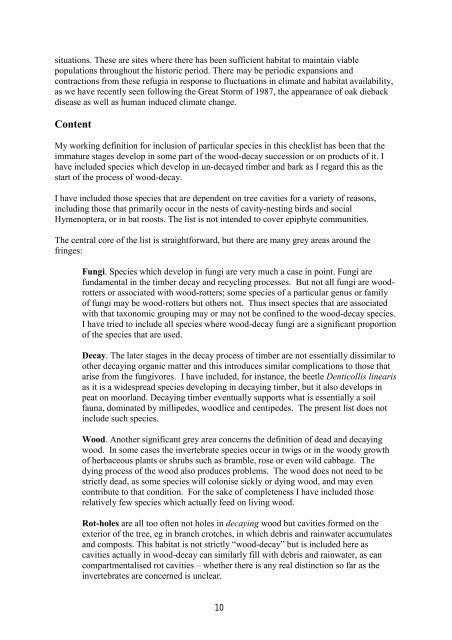Crustacea: Copepoda - Cerambycoidea.com
Crustacea: Copepoda - Cerambycoidea.com
Crustacea: Copepoda - Cerambycoidea.com
You also want an ePaper? Increase the reach of your titles
YUMPU automatically turns print PDFs into web optimized ePapers that Google loves.
situations. These are sites where there has been sufficient habitat to maintain viable<br />
populations throughout the historic period. There may be periodic expansions and<br />
contractions from these refugia in response to fluctuations in climate and habitat availability,<br />
as we have recently seen following the Great Storm of 1987, the appearance of oak dieback<br />
disease as well as human induced climate change.<br />
Content<br />
My working definition for inclusion of particular species in this checklist has been that the<br />
immature stages develop in some part of the wood-decay succession or on products of it. I<br />
have included species which develop in un-decayed timber and bark as I regard this as the<br />
start of the process of wood-decay.<br />
I have included those species that are dependent on tree cavities for a variety of reasons,<br />
including those that primarily occur in the nests of cavity-nesting birds and social<br />
Hymenoptera, or in bat roosts. The list is not intended to cover epiphyte <strong>com</strong>munities.<br />
The central core of the list is straightforward, but there are many grey areas around the<br />
fringes:<br />
Fungi. Species which develop in fungi are very much a case in point. Fungi are<br />
fundamental in the timber decay and recycling processes. But not all fungi are woodrotters<br />
or associated with wood-rotters; some species of a particular genus or family<br />
of fungi may be wood-rotters but others not. Thus insect species that are associated<br />
with that taxonomic grouping may or may not be confined to the wood-decay species.<br />
I have tried to include all species where wood-decay fungi are a significant proportion<br />
of the species that are used.<br />
Decay. The later stages in the decay process of timber are not essentially dissimilar to<br />
other decaying organic matter and this introduces similar <strong>com</strong>plications to those that<br />
arise from the fungivores. I have included, for instance, the beetle Denticollis linearis<br />
as it is a widespread species developing in decaying timber, but it also develops in<br />
peat on moorland. Decaying timber eventually supports what is essentially a soil<br />
fauna, dominated by millipedes, woodlice and centipedes. The present list does not<br />
include such species.<br />
Wood. Another significant grey area concerns the definition of dead and decaying<br />
wood. In some cases the invertebrate species occur in twigs or in the woody growth<br />
of herbaceous plants or shrubs such as bramble, rose or even wild cabbage. The<br />
dying process of the wood also produces problems. The wood does not need to be<br />
strictly dead, as some species will colonise sickly or dying wood, and may even<br />
contribute to that condition. For the sake of <strong>com</strong>pleteness I have included those<br />
relatively few species which actually feed on living wood.<br />
Rot-holes are all too often not holes in decaying wood but cavities formed on the<br />
exterior of the tree, eg in branch crotches, in which debris and rainwater accumulates<br />
and <strong>com</strong>posts. This habitat is not strictly “wood-decay” but is included here as<br />
cavities actually in wood-decay can similarly fill with debris and rainwater, as can<br />
<strong>com</strong>partmentalised rot cavities – whether there is any real distinction so far as the<br />
invertebrates are concerned is unclear.<br />
10

















